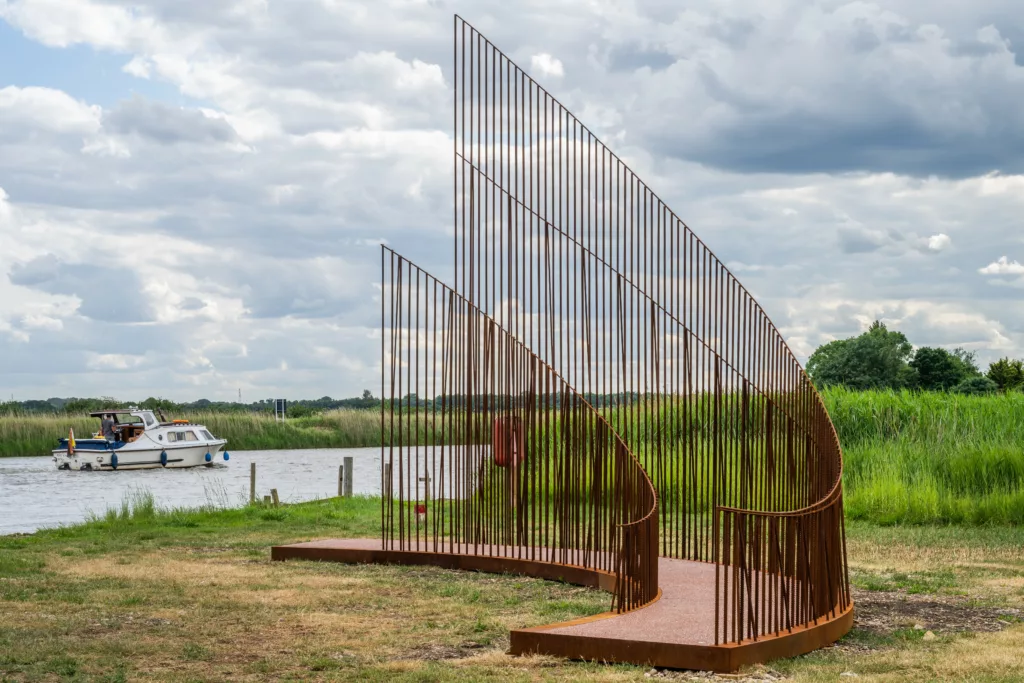
Iron Reef by Studio Maetherea, at Reedham Ferry Inn
Part of the Norfolk Way Art Trail, Iron Reef by Studio Maetherea at Reedham Ferry Inn is inspired by the nautical heritage of Reedham Ferry and is designed to interact with the surrounding landscape. The tides and the river currents change the artwork’s material over time, creating different colours and textures with the passing seasons.
The curved light metallic structure climbs to the sky and interacts with the wind. The vertical elements gently undulate, echoing the reeds on the horizon and inviting visitors to contemplate the changes in season on the River Yare. Winter tides mirror the artwork, blurring the line between the land and the water.
Iron Reef is deeply rooted in the community. Residents took part in a series of creative workshops, exploring the artwork and inviting them to reflect on their experiences. Participants created diary entries filled with interesting stories, poetry, and drawings as well as their experiences of the landscape, alongside sensory walks, which influenced the artwork’s design and composition.
Iron Reef will change through time, shaped by water, plants, animals and people. It’s raised platform, formed of a timber walkway and finished in a bioluminescent material, invites visitors to view the River Yare through vertical steel struts which reach heights of up to 12 metres.
The other artworks which form the Norfolk Way Art Trail are Flock at Diss Mere, Honing Passage at Honing Station, Interval at Eastbourne Place in Norwich and Flint at Norwich Arts Centre
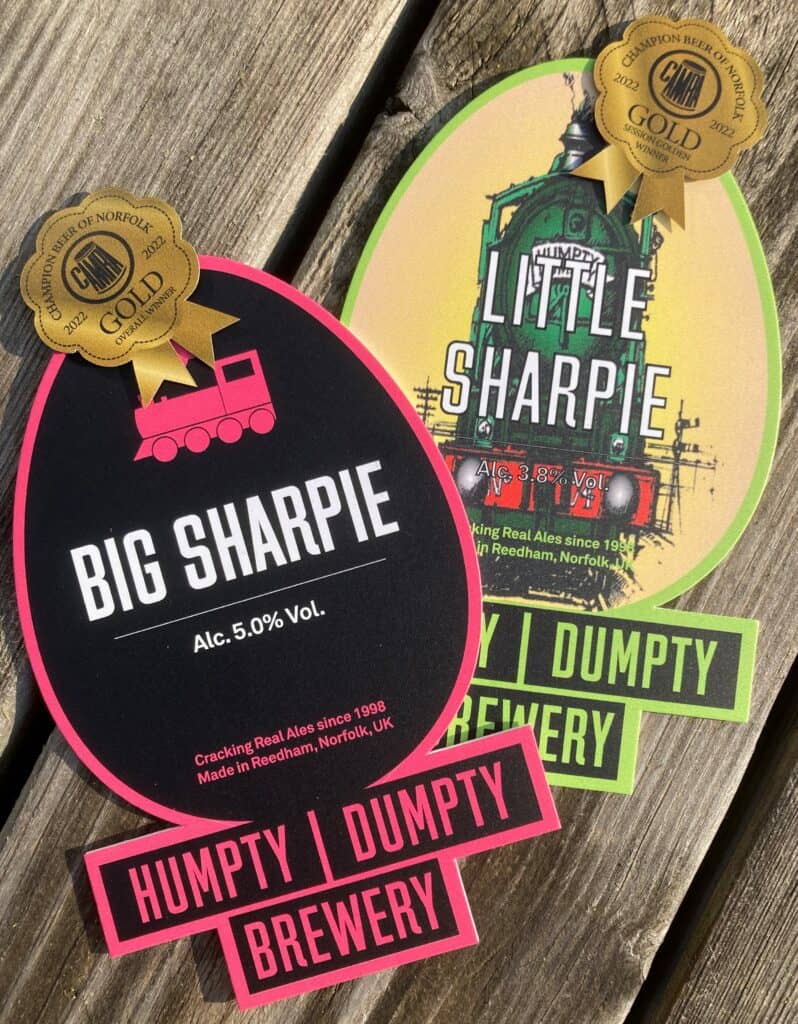
Brewery Visit & Shopping Experience
This Humpty Dumpty never sat on a wall and the name is nothing to do with the nursery rhyme! It’s a friendly multi-award winning microbrewery at pretty Reedham in the heart of the Norfolk Broads National Park, delivering cask and bottled real ales to pubs and venues across East Anglia. The 11 barrel brewplant, produces a wide range of award-wining real ales and very fine locally brewed Broadland beers. This is a chance to visit the brewery, try a few beers & source delicious local produce. Learn how the champion beers are made & how the different Humpty Dumpty brands are developed, many created in collaboration. And find out how a heritage train gave the brewery it’s name!
If you’re looking for foodie presents or gifts for beer lovers, browse the brewery shop, stocked with lots of East Anglian produce from brilliant local independents. It’s great way to support several local businesses at once, as Humpty Dumpty sources materials locally as possible, employs local people and sends their spent grain to local farms as feed for cattle. You’ll find their Humpty Dumpty’s range of bottled beers and tasty ciders, gins, wines, cookies, honeys, preserves, hot chilli sauces and lovely fresh local eggs. You can grab a pint or takeout jug too. Look out for guest ales from other East Anglian breweries and delectable seasonal specials. Humpty Dumpty loves autumn, as September is hop harvesting time. And ends with UK-toberfest, Oktoberfest with a British twist!
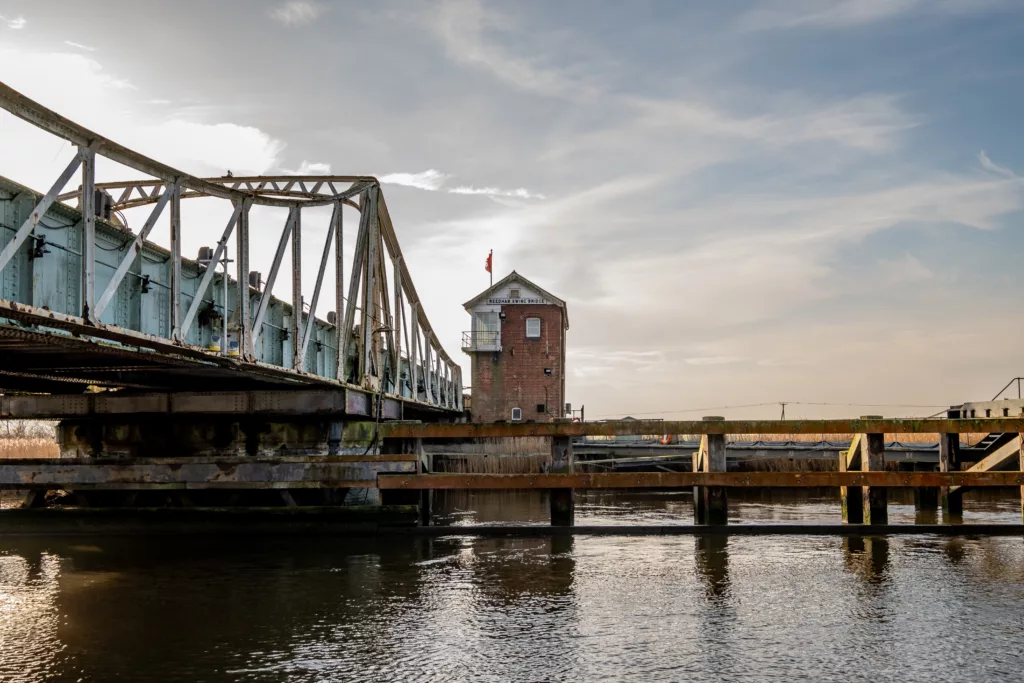
Reedham Swing Bridge
Witness the trains going over the swing bridge and it opening for oncoming boats and vessels. The Reedham swing bridge carries the Wherry railway line, between Norwich and Lowestoft, across the River Yare near Reedham railway station. The original single track bridge was commissioned by Sir Samuel Morton Peto in the 1840s to allow the passage of wherry boats, which were too tall to pass under conventional bridges. The current bridge dates back to 1903 before the doubling of the track. The bridge is operated from the 1904 signal box and in a typical year, is opened 1,300 times.
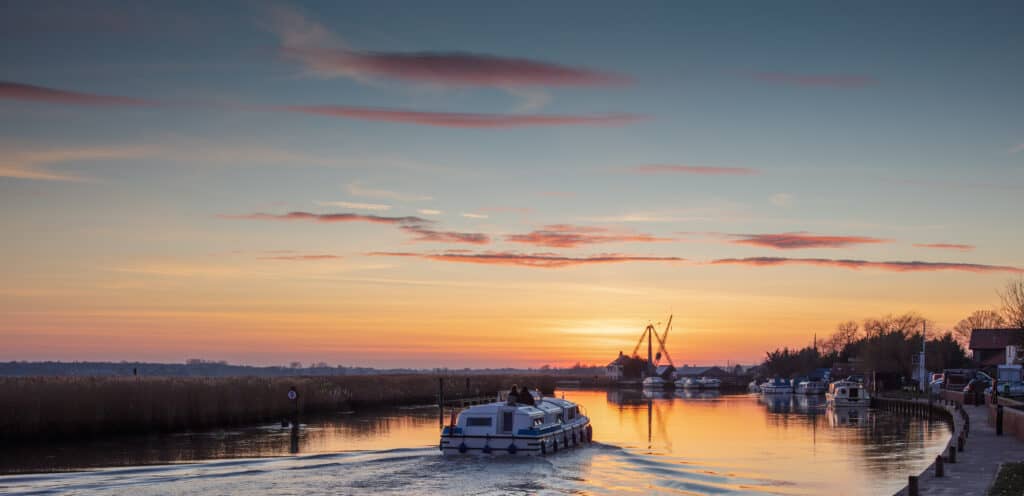
The Black Sailed Traders of Reedham
Victorian visitors to the Broads National Park would have seen over 300 boats skimming the shallow waters, with sails black as raven wings. Nicknamed ‘black sailed traders’ they sound like pirate ships but were traditional working vessels, specially designed for transporting cargo around the heartland of the Broads before roads took the trade away. Experience the wherries’ heyday by chartering the ‘Albion’ with a skipper and mate, named by BBC Countryfile Magazine as one of the Top 10 Boat Trips in the UK.
In past summers, Edwardian skippers scrubbed out the boats’ pungent holds to make a few bob taking genteel tourists on pleasure trips. However, as the sails were black due to being weatherproofed with tar and fish oil it wouldn’t be surprising if smelling salts were occasionally required!
The sails were vast enough to catch the wind in most conditions, but when breezes didn’t suit the wherryman had to walk his boat along using a long quant pole for pushing off the river bed or bank. Losing your grip was poor form. No-one wanted to leave a ‘stick in the mud’.
The small Broadland village of Reedham was a centre for wherry building. The ‘Maud’, launched in 1899, is the last remaining wherry built by the renowned Halls Yard. Together with the ‘Albion’ they’re the only two commercial wherries left. Reedham also showcases two unique river crossing points; the country’s last working railway swing bridges and for cars crossing the Yare, Norfolk’s only operating chain ferry.
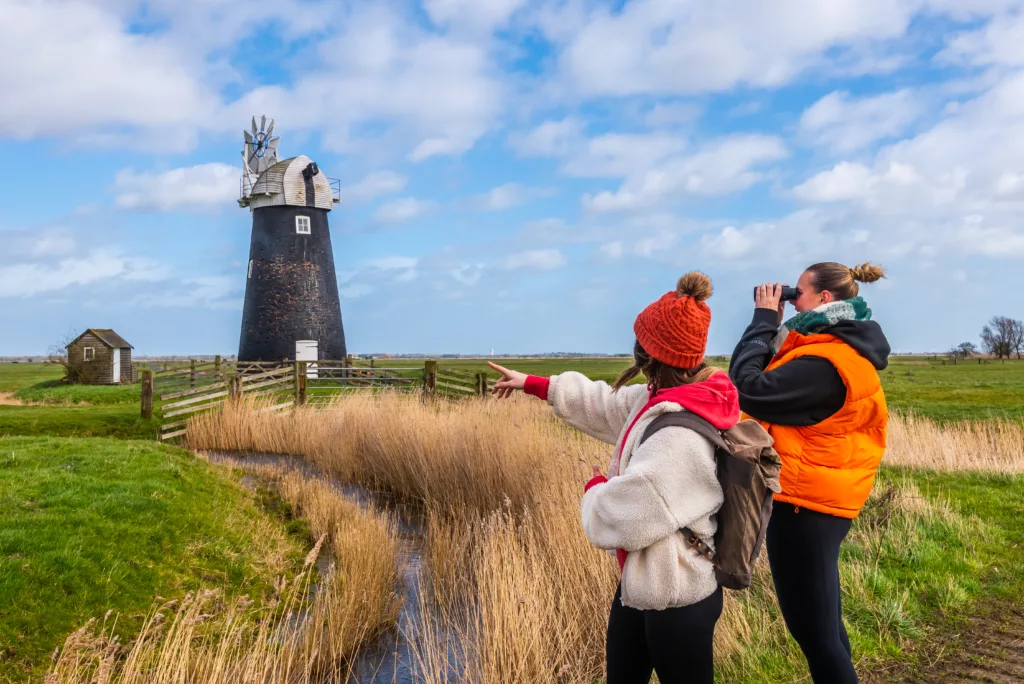
Land of the Windmills
Discover a land of windmills, a flat and wet world of wildfowl, swans, and geese. A place of solitude and escape. Dykes full of blowing reedmace cut across this exposed world, highways for creatures who subterfuge and cover is essential for survival. In winter, wildfowl nibble grass on these expansive grazing marshes. In summer, livestock munch the rich vegetation while swallows catch flies disturbed by trampling hooves.
The vast, open triangular space known as the Halvergate Marshes was an estuary in the Roman period. The town of Great Yarmouth grew up on a sand spit which formed across the mouth of the Estuary. Only Breydon Water survives as a relict part of this once large estuary, the remainder transitioned, initially to salt marsh and later to drained marshland.
People have been living on the marshes for around 1000 years, initially for sheep grazing and salt working. If you look carefully, you can still see a series of mounds or hills on the marshes, which are the spoils dumped by those early salt workers. The word salary is derived from the word salt, which was the currency of the day. Many marsh farms were established on the higher ground formed by the spoil from the salt workings.
By the eighteenth century, an increased number of drainage schemes created conditions suitable for cattle grazing. These cattle were sometimes brought great distances on the hoof from Scotland and Ireland.
The drainage schemes led to the introduction of a large number of drainage windmills, the greatest concentration outside the Netherlands. Many of these survive, often in a semi-derelict state.
The Halvergate Fleet, which runs across the middle of the marshes is a relict watercourse. The original road to Great Yarmouth, the Stone Road, ran alongside The Fleet prior to the construction of the Acle New Road, ‘the Acle Straight’ in the early 1830s.
As well as the Weavers’ Way and Wherryman’s Way long distance paths, two railway lines also cross the marshes but despite these various routes and proximity to Great Yarmouth, the marshes remain a vast remote expanse.
Build your own itinerary
If you fancy creating your own itinerary for a day trip to Norfolk or a longer visit, it couldn’t be simpler. Just go to Search Activities and select from our wide range of free and paid-for experiences, saving any that capture your imagination with the click of a button.
Once you’ve finished, you’ll find all the information stored in My Favourite, where you can drag and drop activities to create your own day-by-day itinerary! You can download this to a calendar and even share it with friends.
